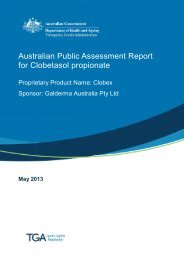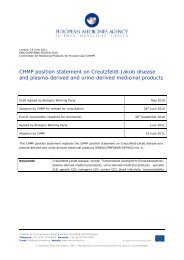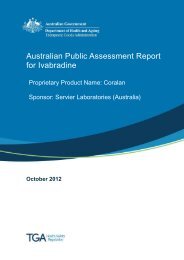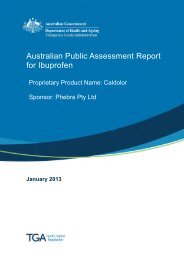AusPAR: Cabazitaxel - Therapeutic Goods Administration
AusPAR: Cabazitaxel - Therapeutic Goods Administration
AusPAR: Cabazitaxel - Therapeutic Goods Administration
Create successful ePaper yourself
Turn your PDF publications into a flip-book with our unique Google optimized e-Paper software.
PSA response<br />
<strong>AusPAR</strong> Jevtana <strong>Cabazitaxel</strong> Sanofi-Aventis Australia Pty Ltd PM-2010-02565-3-4<br />
Final 9 February 2012<br />
<strong>Therapeutic</strong> <strong>Goods</strong> <strong>Administration</strong><br />
PSA was evaluated only in patients who had a baseline PSA > 20 ng/ml (325 patients in<br />
arm A and 329 patients in arm B). The PSA response rate was 17.8% in arm A and 39.2%<br />
in arm B (p=0.0002).<br />
Pain progression<br />
The median time to pain progression was 11.1 months in the cabazitaxel arm but was not<br />
reached in the mitoxantrone arm. There was no statistically significant difference between<br />
the treatment arms (HR: 0.91 and 95% CI: 0.69-1.19).<br />
Pain response<br />
Pain response was evaluated in patients with a median PPI ≥2 on the McGill-Melzak score<br />
and/or a mean analgesic score ≥10 points at baseline (168 patients in arm A, 174 patients<br />
in arm B). There was no statistically significant difference between the two arms of the<br />
study.<br />
Tumour related symptoms<br />
Most of the patients had ECOG scores that remained stable (unchanged from baseline<br />
score). Similarly, in most patients in the two study arms, the PPI score remained stable.<br />
Evaluator’s conclusions on clinical efficacy<br />
This was a randomized, open label, multicentre study to determine whether improvement<br />
in overall survival (OS) would be greater with cabazitaxel in combination with prednisone<br />
than with mitoxantrone in combination with prednisone in patients with hormone<br />
refractory metastatic prostate cancer previously treated with a docetaxel containing<br />
regimen. The randomization and stratification were carried out centrally. Stratification<br />
allowed for analysis of OS in the subgroups, which included age, country, pain at baseline,<br />
PSA status, time from last docetaxel to randomization, docetaxel dose and time of<br />
progression from last docetaxel. The patient demographics and baseline characteristics<br />
were well balanced in the two arms of the study. The study population was a good<br />
representation of the target patient population with almost all (99%) the patients having<br />
received hormone therapy and chemotherapy. About 60% had received radiotherapy. All<br />
patients had previous docetaxel treatment with about 75% of patients progressing while<br />
on docetaxel or within 3 months after of this docetaxel therapy, thus being possible as<br />
being classified as taxane resistant. Twenty five percent of the patients progressing 3<br />
months or more after end of previous docetaxel based therapy. Therefore, it appears that<br />
not all the patients were docetaxel resistant and some may have benefited from docetaxel<br />
rechallenge (although improvement of OS with docetaxel re-challenge in second line<br />
mHRPC has not yet been demonstrated in a controlled study).<br />
The OS in patients treated with cabazitaxel plus prednisone was statistically significantly<br />
longer than in patients treated with mitoxantrone plus prednisone. The hazard ratio (HR)<br />
corresponded to a 30% reduction in the risk of death in the cabazitaxel arm of the study<br />
compared with the mitoxantrone arm. The subgroup analysis of OS showed a trend<br />
favouring the cabazitaxel arm. The effect of liver function on OS showed that the<br />
interaction of treatment and liver function on OS was not significant. This would suggest<br />
that the treatment benefit of cabazitaxel was independent of liver function abnormality at<br />
baseline.<br />
The secondary endpoints also showed benefit in favour of cabazitaxel. The median<br />
progression free survival (PFS) was 2.8 months in the cabazitaxel arm and 1.4 months in<br />
the mitoxantrone arm. Response rates for PSA and tumour assessments were significantly<br />
better in the cabazitaxel arm. Similarly, the time to PSA and tumour progression were<br />
Page 38 of 75
















